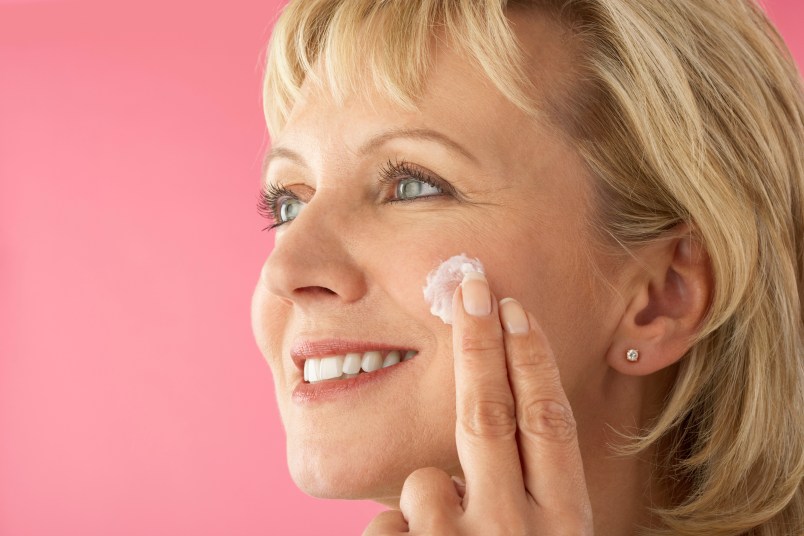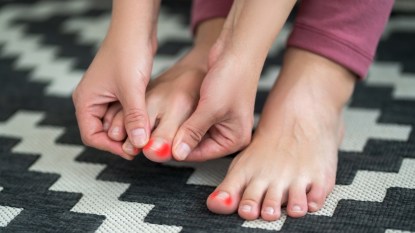Anti-Aging Glycolic Acid Is the Holy Grail of Exfoliating Products

When it comes to using glycolic acid for skin, benefits have to be seen to be believed. This holy-grail exfoliator is said to be the secret to glowing, younger-looking skin. So what exactly is it about this compound that makes it work wonders for your appearance?
What is glycolic acid and how does it work?
As the name implies, glycolic acid belongs to a group called alpha hydroxy acids (AHAs). These acids are naturally occuring substances (glycolic acid is derived from sugar cane) that work well in skin-care products because of their ability to exfoliate skin and repair the damaged layers underneath.
Glycolic acid is considered the top dog of AHAs due to the size of its molecules. It is the smallest AHA, which means it’s the easiest for the body to absorb. What glycolic acid does for skin is break down bonds between the top layers of dead skin cells. “The stratum corneum is the most superficial layer [of skin], and [glycolic acid] removes that, essentially, [to] allow the younger, more vibrant skin cells to be the most visible. It gets rid of the dull, sallowness of the dead skin,” John Paul Tutela, MD, tells WomansWorld.com.
How to Use Glycolic Acid
The first step in introducing glycolic acid is to consult with a dermatologist or plastic surgeon so they can come up with a customized skin-care routine that will work best for your needs and concerns. (They are the experts, after all!) “I liken it to if you’re going to start working out,” Dr. Tutela says. “You may not be able to get a personal trainer three times a week indefinitely, but it’s a great way to start off a new physical training regimen: with an evaluation and a plan from a trainer, and then something you can carry on on your own.”
If you don’t have the time or resources to consult someone, skin-care experts recommend starting with products containing lower concentrations of glycolic acid. “The best way to introduce glycolic acid into one’s regimen is to use a low percentage face wash (eight to 10 percent) a few nights a week,” Adarsh Vijay Mudgil, MD, tells WomansWorld.com. “Once you’re certain your skin can tolerate this, you can up the frequency.”
Dr. Mudgil recommends the Skinceuticals LHA Cleanser Gel ($65.94, Amazon), which contains glycolic acid in addition to LHA (an acid that lifts dead skin cells) and salicylic acid (a pore-clearing acid that’s also used to treat acne). Glytone’s Mild Cream Cleaner ($33, Amazon) is a more affordable option that has a gycolic acid concentration of 3.4 percent, making it perfect for more sensitive skin.
The higher the glycolic acid concentration the better the results, so once your skin has gotten used to a daily glycolic acid cleanser, try something stronger, like a toner or serum. Francesca Fusco, MD, gives her stamp of approval to Pixi’s Overnight Glow Serum ($34.90, Amazon) — a budget-friendly glycolic acid serum. If you feel like splurging, Tutela recommends SkinMedica’s GlyPro line, which contains higher concentrations of glycolic acid. Though they’re both a bit expensive, we recommend the SkinMedica Glypro Antioxidant Serum ($125, Amazon), which will help fight signs of aging, and the SkinMedica GlyPro Renewal Cream ($94, Amazon), which will add softness and plumpness to your skin.
“I’m in love with the entire Skinmedica line. Recently added the Glypro Renewal Cream after the Retinol Cream about 3x a week,” Amazon user C. Grant raved. “Makes a nice difference in the clarity of my skin. I’m in my late sixties and still have oily skin that can break out. Glypro is an added plus to my regimen.”
Another step up from that would be adding a glycolic acid peel to your skin-care routine. Mudgil recommends the Dr. Dennis Gross Skincare Alpha Beta Extra Strength Daily Peel ($84.95, Amazon), which is a simple two-step process you can do daily. For a cheaper at-home glycolic acid peel option, Dr. Fusco likes the Exfoliating Glyco Peel System By Patricia Wexler ($39.14, Amazon), which has a similar application to Dr. Dennis Gross’ peel pads.
Benefits of Glycolic Acid for Skin Over 50
When it comes to using glycolic acid on mature skin, the good news is the rules aren’t much different than they are for younger women. Because older skin may be more sensitive, Mudgil explains that it women over 50 not be able to handle daily application, with the caveat that you should, first and foremost, listen to what your skin is telling you.
“I think that for the older woman, [glycolic acid] is probably going to have a more robust effect just because they have a greater need for it, to be honest,” Tutela says. This makes sense when you consider again what glycolic acid does, as the breakdown of skin cells triggers the body to start producing more collagen, the protein responsible for the skin’s elasticity, and when more of it is produced, existing wrinkles and fine lines may disappear over time.
Glycolic Acid Peels: Over-the-Counter vs. Dermatologist
Given how easy it is to do a glycolic acid peel at home, you may be wondering why people ever spend the money to have a peel performed at a spa or clinic. Despite the convenience of an at-home option, the benefits of a glycolic acid peel done by an expert may outweigh the ease of glycolic acid peel pads.
“For a peel, you’re always best served going to a dermatologist,” Mudgil says. “OTC products are fine to use as cleansers/toners,” but they won’t be as potent as a peel performed by a skin-care expert.
Like all good things in life, beautiful skin takes time and effort. If you want to see more immediate results, you should book an appointment with a dermatologist or plastic surgeon, Fusco says.
Glycolic Acid Side Effects and When Not to Use It
The point of gradually introducing products with glycolic acid and then working up to higher concentrations is to ensure your body is OK with something before you lather your face with it. Too much glycolic acid can burn the skin, but usually the worst side effects are mild irritation, redness, itching, swelling, and skin discoloration. If you notice these glycolic acid side effects, dial down how frequently you use the product or ditch it all together. The most important thing is to listen to your skin.
One unexpected side effect of using glycolic acid is that you should be more vigilant about using sunscreen because glycolic acid will make your skin more sensitive to sun. We know, we know, doctors are always telling us how important sunscreen is — but they’re right! Don’t forget to add sunscreen to your shopping basket before checkout or all the wonderful benefits of glycolic acid will be negated by sun damage to your skin.
As long as your skin shows it can tolerate glycolic acid, using the product is typically safe. However, there are certain conditions when it would not be a good idea to use glycolic acid, such as on “skin that is broken, infected, irritated, sunburned, or immediately after waxing or lasering,” Fusco explains. “[Using it] in any of these conditions could cause skin to become irritated and inflamed.”
Despite its intimidating name, glycolic acid can be added to any skin-care routine for glowing, healthy skin.
More From Woman’s World
Kiss Dry, Chapped Lips Goodbye With the 19 Best Lip-Care Products for Women Over 50













